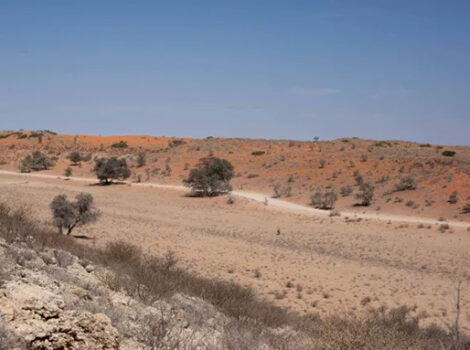
Far off the beaten path, accessible only by 4×4, are Botswana’s Gcwihaba Caverns; a fantastical series of caverns filled with stalactites, stalagmites, and bats. Thousands of bats.
Once a potential explorer reaches the isolated Gcwihaba Caverns, it is not a challenging descent in terms of spelunking, but it has unique challenges of its own. Even the Botswana tourism website warns to be prepared for a storm of flying mammals if you make too much noise.
The main chamber of the dolomite caves, named Drotsky’s Cavern after the first European to be shown the cave in 1934, is a massive clearing in the stone in which bats hang from all the walls. The cave systems are home to at least three distinct species of bat; all of which are harmless, but all of which inhabit the caves in force.
Archeological artefacts have also been found in and around the caves, suggesting that they were once used as shelter for prehistoric man.
Certainly one of the wildest and most remote destinations in Botswana, Gcwihaba is a fascinating underground labyrinth of caverns and pits, linked passages, fantastical stalagmite and stalactite formations, and beautifully coloured flowstones that appear like waterfalls of rock. Naturally, the Gcwihaba Caves have their own eco-system complete with many species of fauna and flora for you to investigate. Most prominent, and typical of any cave system, are the bats.
Unique ecosystems of flora and fauna have been recorded at Gcwihaba. These include the Namaqua Fig, only found at these hills and easily recognisable by its long trailing roots, the endemic aloe, tent tortoises, barking geckos, Ruepel’s parrot (also unique to this region) and barn owls which live in the caves.
Moving from the more commonly used northern entrance, you’ll first come across thousands of bats hanging upside down from the cave walls. The most common species are the Commerson’s Leaf-nosed Bat – the largest insectivorous bat in Southern Africa, the tiny Dent’s Horseshoe Bat and the Egyptian Slit-faced Bat. They are all completely harmless, but as you approach, be prepared for a possible mass exodus– clouds of screeching, fleeing bats winging through the dusty darkness. You will also find tent tortoise, Ruepel’s Parrot and barking geckos, as well as barn owls, who favour the caves as their nesting grounds. The occasional porcupine, leopard and even Hyena have been known to seek shelter within the cavern maze, hence the name Hyena Hole.
Some caverns are up to 10 metres high, some are so tiny that one needs to squeeze, or crawl on the belly, to get through them; and some stalactites measure up to six metres in height, meeting their cousin stalagmites to form organic columns that seem to support the entire cave roof. The main cavern is called ‘Drotsky’s cavern,’ named after the Ghanzi farmer Martinus Drotsky, who was the first European to be shown the caves by the !Kung San in 1934.
Situated on a sand ridge set amongst undulating dunes, Gcwihaba has been part of the Kalahari ecosystem for almost three million years. It was formed during the Pleistocene Age when the area was much wetter. There have been dramatic climatic variations alternating very wet with very dry periods.
Archaeological evidence suggests that the area was inhabited by foraging peoples thousands of years ago. Late Stone Age tools, burnt ostrich eggshells, animal bones, even a fossilised primate skull, have been unearthed in the region. Indeed the caves hold important clues to the way prehistoric peoples related to their environments.
Gcwihaba is a designated National Monument and a proposed UNESCO World Heritage Site.
Widely known as Drotsky’s Caves, Gcwihaba Caves are situated in the Kalahari Desert, just 50kms East of the Aha Hills. They form one of Botswana’s most beautiful and unusual National Monuments, and possibly soon, UNESCO World Heritage Sites.
Easy to miss; Drotsky’s Caves are nestled within the undulating dunes of the Kalahari, below a nondescript low ridge of rock. However, what lies beneath is quite spectacular. The Labyrinthian cave system spreads out below the area, generously littered with the most incredible and unusual stalagmite and stalactite formations. From frozen waterfalls and flowstones to mammoth obelisks of naturally formed rock, from sweeping hallways and chambers, some up to 10 metres in height, to beautiful inlets and apertures, all awash in myriad subtle colours, Drotsky’s caves demonstrate the passage of time in all its petrified glory.
Neither accessing nor exploring Drotsky’s Caves is a task for the faint of heart. Located in one of the most remote parts of Botswana, the Gcwihaba Caves can only be reached via a long and arduous 4×4 route, using well-equipped 4×4 vehicles with long-range petrol tanks and water reserves. There are, however, a number of beautiful camping spots within range of the caves, as well as the traditional village of Xai Xai, within relatively close proximity, and the drive itself, which make the visit well worth the trip.
The caves themselves are extensive and spread over 2 levels through a collection of interlinking passages and caverns. With no guides, no signs or directional indicators and no light, natural or otherwise, one needs to be pretty well equipped with flashlights, other essentials and stamina before considering this spelunking exhibition. Once inside though, the route through the caves is relatively easy to walk, with only a few areas that require scrabbling, wiggling and scrambling and generally steely nerves.
To read more about this incredibly beautiful cave system you can look at the Botswana Tourism website or Proudly African.
Sources: traveladventuresbotswana.com, botswanatourism.com
Image source maps.prodafrica.com



